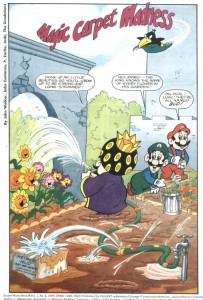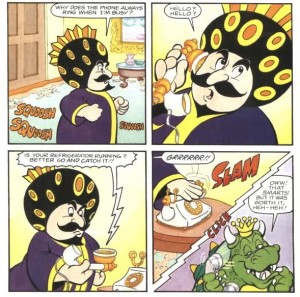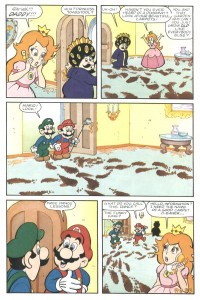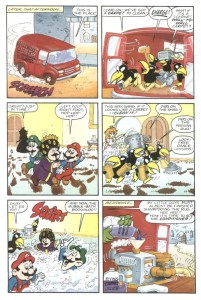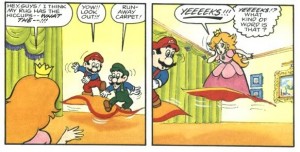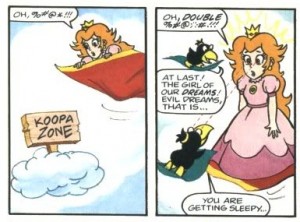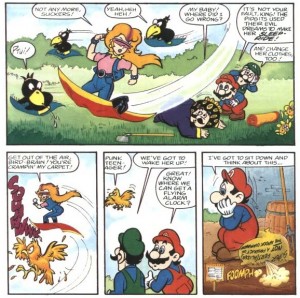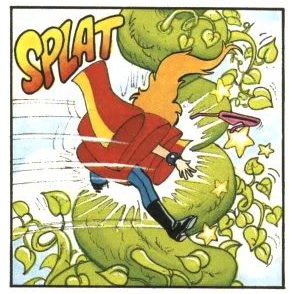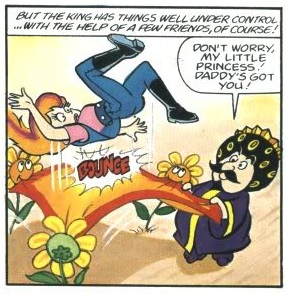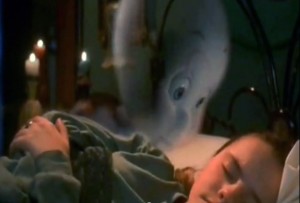Posts Tagged Comics
Accolades with an Asterick
Posted by kjohnson1585 in Animation, Comics, Film, Music, Television, Uncategorized, Writing on January 11, 2012
Andre 3000’s hit single “Hey Ya!” is a gleefully hyperactive song, fusing a classic rock sensibility with a modern, funky chic. It exploded on the scene in 2003, in a strange moment, when Outkast, a duo with a string of underrated, entertaining albums from Southernplayalisticadillacmuzik to Stankonia, decided to release separate ones. They weren’t splitting; they were exploring different things. Speakerboxx/The Love Below was the outcome. At the time, critics marveled over Andre 3000’s The Love Below’s eccentricity and random energy, and casually accepted Big Boi’s Speakerboxx. What makes this particularly weird is that Speakerboxx was inherently the better product, a fact that’s much more obvious today by most mainstream musicphiles. The Love Below is a nifty experiment, but there’s a really blatant truth here, which is most obvious on “Hey Ya,” but has yet to be quite understood: Andre 3000, while a great rapper, isn’t a good musician.
“Hey Ya” bounces and rolls with the immensity and grandeur that a great pop song can be. It works well in clubs and parties, and brightens the spirits as it bounds through its synths, basses, and fake guitar/xylophonist melodies. It’s great as a wonderful 50s-esque rock homage; not so much as a modern rock song. Andre 3000 cut his teeth as a rapper, so his voice is barely registering in this song (mainly due to the fact he can’t hit the notes, choosing to drown his voice out instead). I don’t hate “Hey Ya” (although I never loved it). It’s good, but it’s good with an asterisk.
The middle of aughts was a really, really strange period. It was around that time that Youtube REALLY hit its stride and entertainment across the board started to pick up. Artists were finding success in niches, and it seemed that executives were trying to find the formula for recapturing the splitting markets. Options? Catering to new demographics was an idea – Desperate Housewives, The Sex in the City movie. Another option was experimentation. It worked in the early 90s, when animation ripped into the TV landscape with new, bold stuff. And in desperate times, why not try it again?
Lost was such an experiment, the ABC, 6-season mindfuck that, well, didn’t turn out to be a mindfuck. A moment in time, the perfect moment for a drama to break the landscape for what could be shown on TV. It was, essentially, an art film as a TV show. Expertly acted, crafted, designed, and displayed. A buffet of skilled workmen behind the scenes, who, despite what the most hardened critics say, left viewers and audiences unsatisfied. Period.
What happened in the post-Lost TV world was, well, nothing. The real TV-game changers were The Office, Adult Swim and 24. The Office defined Thursday night comedy for NBC, and while not a ratings-smash, defined new niche comedies that a network could expunge. Adult Swim opened the niche of singular voices in animated and non-animated comedy. 24, while ridiculous, pretty much defined serial television, showcasing the ability to not possess self-contained shows to be a hit. In the advent of DVRs, Netflix, streaming, and torrents, it seems strange that television is still marred in the classic mode of storytelling. Although, it is starting to break.
The truth is, Lost did not end well. It failed to tie in its plot lines, it failed to define a followup (some people suggest Fringe, although that’s more akin to X-Files), and, well, even as a casual fan of the show, there’s no desire to go back to it. The strange thing is, Lost, like “Hey Ya,” had so much raw impact at an individual level, but came to mean nothing in the end. “Hey Ya” falls in being sung by a not-good singer on a weird but not-that-great of an album. Lost, with no strong narrative and no real endgame, failed as a TV show. Good, but with asterisk.
I also humbly submit Pan’s Labyrinth as the film equivalent of good, asterisked media. Guillermo Del Toro is an craftsman director, a visionary into the heart of creations and monsters – a modern day Henson, more or less. And while Pan’s Labyrinth had the rich fairytale rhythms and acting that hit all the right notes, it was a not-so-consistent story. The “fairytale” theme became more of a gimmick, an excuse for characters to randomly act out of character. Looking back on the question of its dream/non-dream settings, I keep wondering why and how the film managed to get to certain points without acting wildly out of sync. I can’t imagine re-watching this without a rub of the chin and a cock-eyed expression. Who has it in their top fifty films? What did we really like about this again?
The asterisk is there because I want to be clear: this is different that the typical cultural embarrassment that we’re usually engaging in. This isn’t the Macarana, 80s power rock ballads, bland raunchy comedy, 60s animation, or other forms of entertainment that was terrible content-wise AND media-wise. “Hey Ya,” musically, is solid, just as Lost was masterful television and Pan’s Labyrinth visually arresting. But as “music,” as “game-changing TV,” as “the cinematic experience,” these three mid-2000 reeked of some missing element, a lack of commitment to the real core issue – entertainment that was aggressively “forest for the trees.” In other words – Andre 3000 can’t sing, Lost failed to have an endgame, and Pan’s Labyrinth’s characters made too many uncharacteristic decisions.
Today’s entertainment seems to have taken the lessons ultimately learned from this and created… well, not better-quality material, but better contained material. Although if Terra Nova, the DC comic reboot, and Thundercats (more on this later) are the norm, then we may just be coming back full circle.
Super Mario Comics – Magic Carpet Madness
Posted by kjohnson1585 in Animation, Comics, Super Mario Comics, Video Games, Writing on October 6, 2011
This next Super Mario Adventure comic, similar to “Just Desserts”, is riff with potential but falls short of narrative closure. It’s also a little goofier, more cartoony than the typical batch of comics in the anthology. Mario and Luigi are kinda tossed aside here as the comic relief, focusing on King Toadstool and Princess Toadstool. The next comic will play around with the brothers and their relationship; but this will give me a good opportunity to discuss the dynamics of the daughter/father relationship here.
King Toadstool isn’t that smart. He’s a loveable teddy bear, in which both words – “teddy” and “bear” – have tremendous weight. He doesn’t really think in terms of what’s best for Mushroom Kingdom, seemingly more content to sleep, eat, work in his garden, and otherwise sit around. (On occasion he will exercise a tremendous amount of rage, but it’s pretty rare, and usually comes from somewhere incompetent.) He loves his daughter, that much is for sure, but otherwise seem clueless when it comes to relationships, both private and public. It’s pretty clear the Mushroom Kingdom would be in shambles if it wasn’t for Toad, newcomer Wooster, and, most importantly, Princess Toadstool.
Every comic representation of Princess Toadstool has always been amazing; even the worse stories have managed to make the pink-dressed princess endearing in some way. She is also the most consistent. She balances herself between a classy, formal, slightly naggy feminine figure, and a badass, sarcastic, aggressive, fighter. The balance is less practical and more hilarious, but it also gets the job done. It’s pretty cool to see in this comic how she bounces back and forth between girly and grizzled.
We begin with a pretty solidly constructed establishing panel:
Note the Betty Boop-esque anthropomorphism with the flowers. Yeah, we’re in the cartoon realm here. It kinda reminds me of the judgmental bushes in “Piranha-Round Sue.” Seems the artists tend to use the anthropomorphic construct on background objects to reflect the overall tone of the panel in question. I can’t say it’s too effective – I mean, the dialogue and the coloring already reflects that – but it also a good visual cue to showcase that what you are reading is not, in any way, supposed to be seen as real or realistic. We’re off to a whimsical start.
The king walks inside the palace to answer a phone call – but is annoyed when it’s revealed to be a prank. But, by Bowser? More foreshadowing. I like how quick the tension starts – this is only the second page. What’s he up to?
While I love Princess Toadstool’s reaction to the muddy mess her father left (even the most machismo guys would flip a shit at that), seeing the Mario Bros. mistake the footprints as free dancing lessons is lame, even by 80s and 90s standards. Even if they’re being funny about it… I don’t know. It reeks of randomness, or more appropriately, a joke for joke sake, without putting too much thought behind giving the Mario Bros. any credibility. They’re kind of worthless throughout this comic. Also, Princess Toadstool’s direct comment to her father about “just growing old”? Surprisingly dark and somewhat cold. But, seriously, this is how she is. It’s crude, but so princess-y, and so amazing.
Princess, being practical, calls for a carpet cleaning service. Who arrives? Why, multiple pidgits (the black bird thing from the first page)! Also, they arrive in a van, which means the Mushroom Kingdom has cars. Nice to know they aren’t a completely nature-oriented species. (They also have airplanes and blimps, which appear later.)
So they clean the carpet, while Mario, Luigi, and the King continue to dance in the suds. It’s eye-rollingly annoying, and the jokes are the weakest elements here. There’s being silly, and being stupid, and when most of the cast just acts dumb, it drags everything down – which includes an insanely moronic future comic called “Duh, Stupid Bomb” later in the series. But I digress. As the carpet is conditioned, familiar Bowser-hands add in the secret ingredient Flying Carpet Juice, which looks like grape juice. As the namesake, the carpets begin to fly. In a pretty egregious error, the entire carpet doesn’t fly, but the various small rugs the characters HAPPEN TO BE STANDING ON fly. Also, why they just don’t jump off is unclear, especially the brothers, who are master jumpers. Just… guh, frustrating.
But we get some great Princess Toadstool moments. In the midst of carpet chaos, she has a profound thought:
She then starts bitching about stuff. Say what you will, but if this was happening in my house, I’d suddenly be mad about everything, too.
Which leads to my favorite moment – Princess Toadstool swearing. Twice:
Sure, it’s edited. But it’s there. She clearly drops to F-bombs as she reaches the (sigh) Koopa Zone (is this King Koopa’s airspace? How’d he negotiate that, right over the palace?!). Watching her Majesty just work through these panels is quite a delight. She’s commanding, snappy, random, and concerned all in the span of a few pages. And, with a bit of hypnosis…
She’s badass.
On closer inspection, this is a REALLY crazy moment. Notice the King immediately assuming his bad parenting. Take a gander at specifically what the Princess is wearing. Notice how she suddenly has complete control of the carpet. She even fucks with a random bird, who calls her a “punk teenager” (in case you didn’t get it). The funny part is that I could really see her being like this with not that much of a nudge. She’s incredibly snarky throughout the comic, who has more of a hipster personality more than anything, personified through some feminine wiles. It’ll be much clearer later on.
Nothing comes of any of this though. Mario sits on some plant food, which spills onto some beans, which grows into a giant beanstalk. They climb it in what seems to be like some attempt to grab her, but —
— she slams into the beanstalk instead because she was talking shit to a blimp. Kinda cute, but she’s falling, and about to DIE. Luckily, King Toadstool redeems his parenting skills:
And all is well. Mario and Luigi were useless all throughout, and Koopa got his, although in a whatever-kind of way. Still, King Toadstool’s lines in that panel are as sincere as they come. You cannot deny that father-daughter love, no matter how old Princess Toadstool wants him to get.
“Magic Carpet Madness” is pretty weak all over, but the nice moments with the Toadstool family dynamic have some solid underpinnings that will be worked on and refined in future issues. We’ll see more Princess Toadstool awesomeness in the next couple of issues as well, but next up is in-depth look at the Mario/Luigi relationship, one that will be a treat to explore and write about. That idea of Luigi being second to Mario’s heroics and character? Think again.
CHILDHOOD REVISITED: CASPER
Posted by kjohnson1585 in Childhood Revisited, Comics, Film, Television, Uncategorized, Writing on April 4, 2011
Casper – (1995)
Director: Brad Silberling
Starring: Bill Pullman, Christina Ricci, Malachi Pearson
Screenplay by: Sherri Stoner, Deanna Oliver
Cartoonists Seymour Reit and Joe Oriolo created a phantasmagorical little boy in the 1930s named Casper, a friendly ghost who refuses to eschew the rules of the metaphysical, opting to try and befriend the mortal instead of haunting or scaring them. First as a children’s book and then as an animated cartoon, Casper’s foibles center around his attempts to communicate with people who consistently, automatically freak out and run for the hills. It’s a simple enough premise, mixing the whimsy of idealized Halloween with the creepy comradeship that the macabre can bring, all presentable for the young. And it worked; cartoons of the youthful spirit were created well into the 60s; even today, there are a ton of direct-to-DVD and simple cartoons out there. All of which were more or less spring-boarded by the 1995 film. Hope the re-watch won’t be horrifying! Etc.
NOSTALGIC LENS: I was quite effected by the film when I originally watched it, and I remembered it being surprisingly dark. It’s a difficult line to walk, trying to make a film about death and “what happens next” for kids, who certainly don’t do too much thinking about it. Still, I remember it being fun and chilling, impressed by the ghost effects, and quite enamored by the story. Boy, was I in for a trick-or-treat! Okay, I’ll stop.
DOES IT HOLD UP: When I re-watched this, my immediate first thought was, “This HAS to have been written by two writers.” Sure enough, two names appeared under the Written By credit, and it makes sense. It’s was like watching 2 separate movies in one, barely connected by a thread. One wanted to write a goofy kids film about a young specter wanting to meet a real girl and go to a school dance. The other wanted to write a dark tale of a loss, control, obsession, and shades of abuse. Instead of trying to fuse these ideas together, they just mixed and matched sections of each screenplay and plopped out a finished product. Scenes are starkly black and white in tone, instead of the smooth gray it should be.
Widower doctor (Bill Pullman) and his daughter (Christina Ricci) constantly move from place to place as the former seeks to “communicate” to his deceased wife, and the latter rolls her eyes, or something. Meanwhile, lonely ghost Casper tries desperately to befriend anyone brave enough to enter his haunted mansion, only to be scared off by his triple ghostly companions (or more accurately, owners) of Stretch, Stinky, and Fatso. MEANWHILE STILL, Cathy Moriarty and Eric Idle are two typical corporate-types who want to destroy the mansion for generic money-making scheme #8, but end up discovering a secret within the house, so they switch to generic money-making scheme #14.
Sounds messy, right? It is, but not overly so. It’s more or less three ideas told in five-to-seven minute chunks, and the ideas themselves are simple enough so it’s easy to follow. Also, the direction and editing is clean and straight-forward. Nothing special, nothing exciting, but just passable enough so as to not call anything into question – if you’re a kid.
Older viewers, however will call shenanigans on the parts that seem especially off-putting or nonsensical. For example, an early sequence has Pullman fighting the goofy ghosts with a plunger and vacuum cleaner. Funny, silly kids’ stuff, right? Well, after trapping the ghosts in the vacuum, the following scenes act as if THAT NEVER HAPPEN. Stretch, Stinky, and Fatso are suddenly freed and out and about – without any indication on how or why they were released. The idea, that Pullman is trying to talk these ghosts into “moving on,” is never exactly relayed to the trio of spooks. We’re supposed to assume this.
Balancing the dark with the goofy is never easy, but in Casper, the “dark” borders on horrifying territory. Watching Casper being physically abused by Stretch, Stinky, and Fatso comes off disturbing, not cute. A scene where those three basically ridicule Pullman’s dead wife is starkly cold. The worst thing, though, comes from the film’s attempt to utilize a piece of dialogue that works in the thematic sense throughout the film. The line? “Can I keep you?”
My “rival” is dead correct – that line is just fucking creepy. It doesn’t even really make sense. Part of me thinks its a child’s mistaken approach at romantic terminology (he sees it like one sees a pet or a toy), but the line directed at a young Ricci by a DEAD thing makes it come off much more terrifying.
There are some really nice moments, though. Casper recounting how he died is pretty heartfelt, an interesting approach to something that probably didn’t matter to the original run. And these final scenes are surprisingly dramatic: live-Casper and Ricci’s dance is cheesy good in the 90s sense, but Pullman’s revisit by his wife is actually quite powerful:
Beyond that though, there’s a lot of random moments, including the stuff with Moriarty and Idle, which doesn’t serve too much purpose, and is resolved in a silly way (there’s actually a weird moment where Casper and Ricci run from the ghost version of Moriarty, only to come back. Inexplicable.) Casper’s dual-narrative doesn’t exactly fuse together all that well, but it has moments of liveliness to combat the incomprehensible dread.
Oh, and Dan Aykroyd makes an early appearance as a Ghostbuster. That was kinda cool.
NEXT UP: Heavyweights



